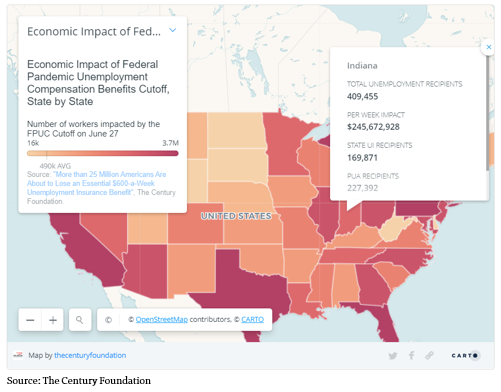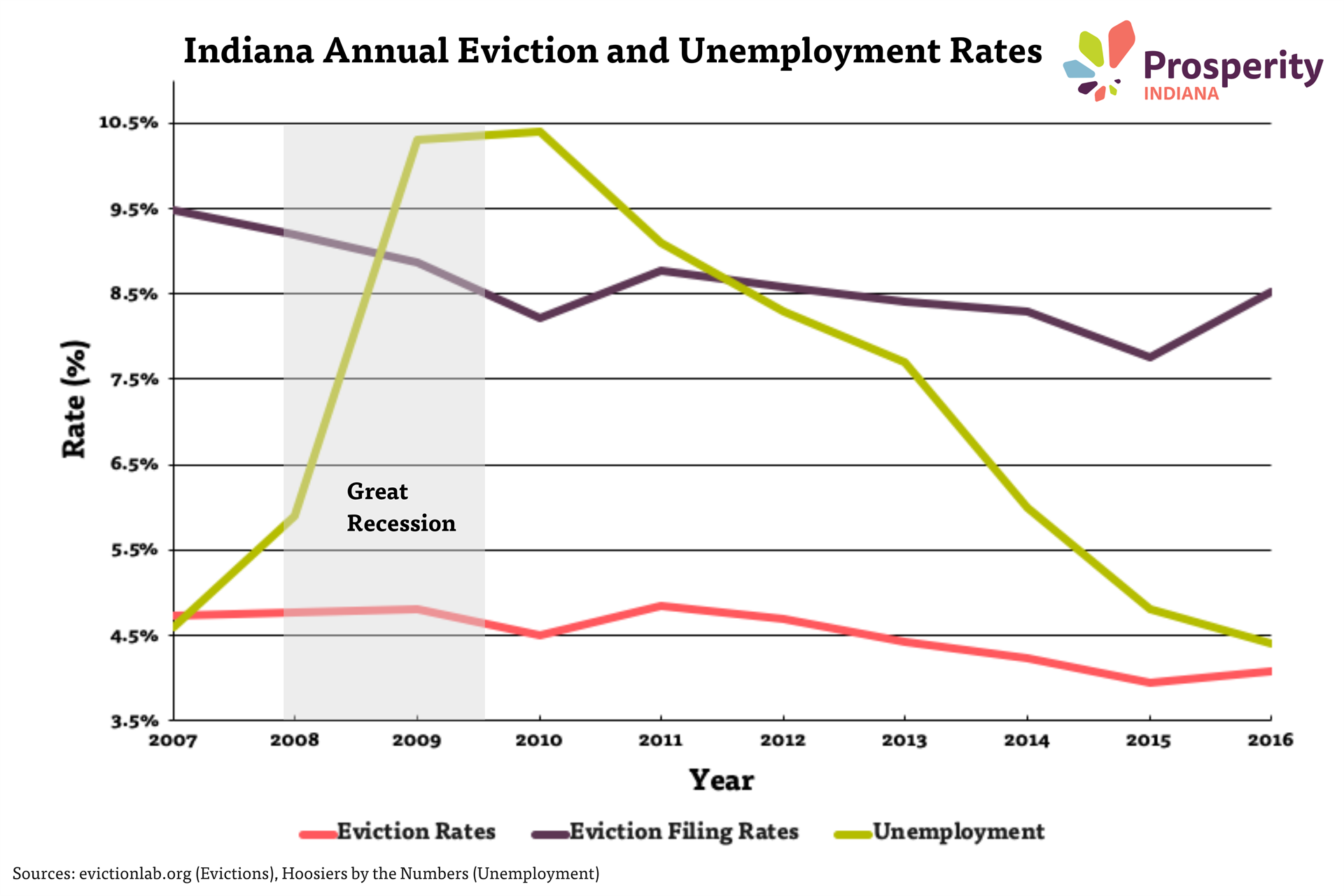FOR IMMEDIATE RELEASE
July 10, 2020
Andrew Bradley, Policy Director
abradley@prosperityindiana.org, 317-222-1221 x403
It’s common to hear that Indiana will face a ‘tsunami of evictions’ sometime after the state moratorium on residential evictions expires on July 31. But based on the evolving nature of the COVID-19 pandemic and the economic crisis that has followed and using what we know from past recessions, Indiana’s policymakers must prepare now for more than the first wave of the tsunami. Rising and falling with the economy, multiple waves of evictions are likely to last at least through 2021, as state and federal unemployment and current pandemic assistance expire and families exhaust any remaining resources. Failing to adequately provide and coordinate housing stability resources throughout this extended storm season could result in long-term damage to Hoosier jobs, public health, and the economy.
The best state estimates find that 258,782 Hoosier renter households affected by the pandemic will need emergency rent assistance by September 2021. But even as unemployment claims are expected to gradually decrease over the coming year, 186,069 households will continue to need pandemic-related rent assistance by June 2021. Over that time, we are likely to see those evictions come in several waves:
The first wave lands August 1: When the Governor’s eviction moratorium ends July 31, the first wave will hit on August 1 when landlords can again initiate evictions for any delinquent rent. National estimates find that for every 10 successful unemployment claim filings, three to four people tried to apply but could not get through, and two more found the system too difficult to attempt to apply. In addition, people at risk of homelessness may have had difficulty receiving the federal stimulus payment. So with nearly 850,000 Hoosiers claiming unemployment since March 21, up to 500,000 more Hoosiers never received state or federal unemployment or pandemic assistance and may be among that first wave of evictions. Because these Hoosiers did not receive a substantial income replacement, even with city or partial state rent assistance available, these families likely won’t be able to make ends meet to avoid immediate eviction, without coordinated non-governmental resources or an abundance of landlord cooperation.

The second wave begins to land September 1: 409,455 Hoosiers are set to lose a total of $245,672,928 per week in unemployment benefits starting on July 27 when the Federal Pandemic Unemployment Compensation (FPUC) expires. If one in three of these recipients has been relying on FPUC for rent, policymakers should expect a new wave of 136,485 evictions in Indiana, beginning when rent is due in September. Even for those who are among the 12,000 families who receive $500 per month in Indiana’s COVID-19 Rental Assistance Program – while continuing to receive the average state unemployment benefit of $272.72 after FPUC expires, the assistance still doesn’t add up to the $834 per month needed for the average two-bedroom apartment in Indiana. The bottom line is that, without an extension of federal pandemic unemployment assistance, over 100,000 Hoosier households will be vulnerable to eviction starting September 1.

The third and biggest wave won’t crest until 2021: The U.S. officially entered recession in February. Although the sharp spike in unemployment and associated public health risks make the COVID-19 recession unique, Indiana’s policymakers should be prepared for evictions to again be a lagging indicator, with a wave that comes a year or more after the peak of unemployment. Following the Great Recession, which lasted from December 2007 to June 2009, Indiana’s peak monthly unemployment rate of 11% occurred in January and February of 2010, with an annual average for that year of 10.4%. But Indiana’s evictions actually dipped that year, and didn’t peak until the following year, with an eviction rate of 4.9% and an eviction filing rate of 8.8% in 2011. These rates very slowly declined over the next five years before again rising, starting in 2015. If Indiana’s unemployment rate of 17% in April 2020 turns out to be the peak from the COVID-19 recession, the state can expect the resulting wave of evictions and eviction filings to peak sometime in 2021. However, if the recession continues or is exacerbated by a second wave of the COVID-19 public health emergency, the wave of evictions could crest again in 2022 or beyond. After a year or more of recession, without additional resources, this wave could devastate Indiana's renter community and economy.
Indiana is not yet ready for the first eviction wave, much less three or more. While Indiana has built a pipeline for emergency rental assistance and homeless prevention with the Indiana COVID-19 Rental Assistance Program and several city-based programs, state leadership has not yet provided proportional resources or coordination to cover the need statewide. This is preventing city and state agencies from aligning available funds and ensuring resources get to where they’re needed most. Prosperity Indiana and The Hoosier Housing Needs Coalition have recommended that Governor Holcomb appoint a Housing Stability Task Force with members that represent renters, housing providers, and experts in the connections between housing and public health. More data will be needed once the state and city programs are operational – and after Indiana’s eviction moratorium expires – to gauge the effectiveness of outreach, utilization rates, and need for additional funds for these efforts. Indiana’s Congressional delegation must also provide adequate resources for housing stability to prevent each eviction wave from sinking Hoosier families.
“Without having a more coordinated system for rental assistance delivery to pair governmental and nongovernmental resources, it’s hard to know just how unprepared we are as a state to address the first wave of evictions that’s coming,” said Jessica Love, Executive Director of Prosperity Indiana. “But knowing the total of what’s been announced as available through state and city administered federal resources to date, without more, we are certain the second and third waves of this housing crisis will result in a major wipeout for housing stability for families in this state. Without more and better coordinated resources to mitigate the coming storms, massive evictions will undoubtedly become Hoosiers’ ‘next normal‘,” Love said.
Several issues pre-date COVID that exacerbate housing instability in Indiana during this new crisis, and should be taken into consideration for long-term policy solutions. Even before the pandemic, nearly 40%of Hoosier households had less than $400 saved for emergencies. Indiana also already had an eviction crisis with an eviction rate of 4.07 in 2016 (above all neighbors and the national average of 2.34%), with three cities (Indianapolis, Fort Wayne, and South Bend) among the top 20 in the U.S. for high eviction rates.
A rule of thumb of ‘one in three’ unemployment recipients needing emergency rent assistance aligns with the rate of 31% of Indiana residents are renters, according to U.S. Census data, as well as a mid-range estimate, as studied by the Urban Institute in ‘The Price Tag for Keeping 29 Million Families in Their Homes: $162 Billion,’ March 27, 2020 https://www.urban.org/urban-wire/price-tag-keeping-29-million-families-their-homes-162-billion.